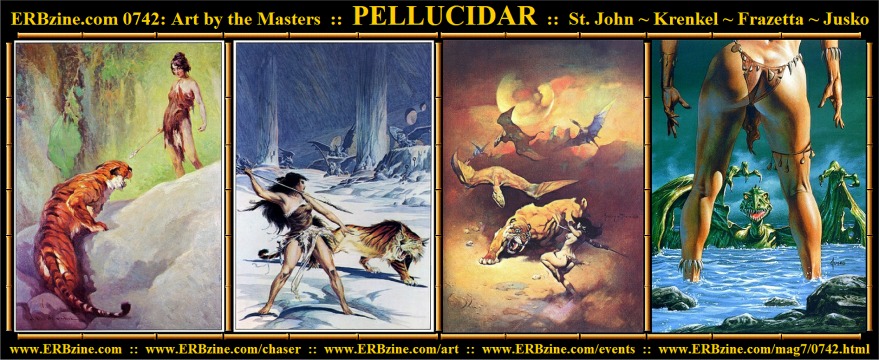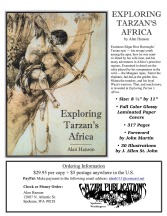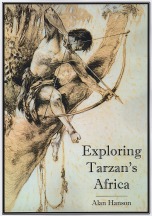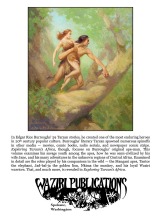Burroughs Battles:
Building a Human Empire in Pellucidar
by Alan Hanson
 Like many young men of his era, the
young Edgar Rice Burroughs envisioned adventure in the life of a soldier.
His father was one, and so the son sought to be one as well. He took a
military education, and at the age of 19 in 1895, he graduated from Michigan
Military Academy. In May 1896 he enlisted in the U.A. Army and was sent
to Fort Grant, Arizona. The life of soldier on the frontier, however, was
not the adventurous one he had dreamed of in his youth. Within months he
began looking for some way to get out of the army. Finally, after 10 months
of chasing Indians who didn’t want to be found (and weren’t), ERB got his
discharge from the army on March 23, 1897. A couple of years later, Burroughs
volunteered to join Teddy Roosevelt’s “Rough Riders” but wound up on the
sidelines during the Spanish-American War. At age 42, he was too old to
fight when the Great War broke out in 1917.
Like many young men of his era, the
young Edgar Rice Burroughs envisioned adventure in the life of a soldier.
His father was one, and so the son sought to be one as well. He took a
military education, and at the age of 19 in 1895, he graduated from Michigan
Military Academy. In May 1896 he enlisted in the U.A. Army and was sent
to Fort Grant, Arizona. The life of soldier on the frontier, however, was
not the adventurous one he had dreamed of in his youth. Within months he
began looking for some way to get out of the army. Finally, after 10 months
of chasing Indians who didn’t want to be found (and weren’t), ERB got his
discharge from the army on March 23, 1897. A couple of years later, Burroughs
volunteered to join Teddy Roosevelt’s “Rough Riders” but wound up on the
sidelines during the Spanish-American War. At age 42, he was too old to
fight when the Great War broke out in 1917.
Edgar Rice Burroughs was destined
to share his dreams of bloody battles and glorious victories in his fiction.
By my count, he included 26 major battles in his stories over through the
years. Three of those battles — The Battle of the Pass of Ancients in The
Moon Maid and the two Battles of Lustadt in The Mad King
— have been detailed here previously. The stories of three more Burroughs
Battles, all fought on the land and seas at the earth’s core, are described
below.
The
Battle of Prospector Plain
(At the Earth’s Core)
The
fates of Pellucidar’s human and Mahar races were at stake when their “fair-sized”
armies met for the first time, probably in what was late September 1912
on the outer earth calendar. The battle was brought on by the actions of
a man who was not even a native of the inner world. The Mahar army was
in the field searching for the Great Secret, the book containing the formula
basic to their race’s existence. David Innes had stolen it, and while the
Mahars searched for him, he was busy forging the first human alliance in
the history of Pellucidar.
Innes first sold his idea of a human
confederation to tribal chieftains Dacor the Strong One of the Amozites
and Ghak the Hairy One of the Sarians. When word spread that David was
teaching the humans to make swords and bows and arrows, other nations flocked
to the banner of the newly chosen first emperor of Pellucidar.
David was preparing the prospector
for a return to the outer earth when the Mahar army found him. It was obvious
that the Mahars considered the outcome of this campaign of monumental importance,
as a great number of them were accompanying the army of Sagoths, who were
usually sent out alone to inflict the Mahars’ violence on the inferior
human race.
The battle strategy used by the
new human emperor was designed to make use of new weapons, about which
the Mahars and Sagoths knew nothing. Ghak and his Sarians were deployed
on the right of the line, with Dacor on the left and David commanding the
center. A “sufficient” reserve under one of Ghak’s headmen waited
behind them. With menacing spears, the Sagoths advanced unchecked until
they came within easy bowshot, at which time David gave the word for the
first volley of poison-tipped arrows to be fired. The Sagoth front line
withered, but a second wave charged over the bodies of their dead mates
in an attempt to bring their spears to bear upon the humans. A second volley
of arrows gave momentary pause to the Sagoth advance, giving the human
reserve a chance to jump through the firing line to engage the Sagoths
with sword and shield.
The Sagoths’ clumsy spears were
no match for the lighter ones of the emperor’s men. Meanwhile, Ghak led
his archers along the enemy’s flank and poured volley after volley into
the unprotected left of the Sagoths. The demoralized servants of the Mahars
wavered, and when David and Dacor led their men with swords upon the Sagoths’
right, the gorilla-men turned and fled. The humans pursued them for some
time, taking many prisoners and recovering nearly a hundred human slaves.
Among the prisoners were a number
of Mahars, who played a very small role in the combat on Prospector Plain.
For the first time members of Pellucidar’s “dominant race” found
themselves at the mercy of one of the “lower orders” of their world. For
the Mahars, the battle was a humbling beginning in what was to be a mighty
struggle for possession of the inner world. For the human race, however,
it was a glorious start on the march to predominance under the leadership
of their emperor from the outer world.
The
Battle of Sojar Az
(Pellucidar)
The
first real naval battle ever fought upon the Pellucidarian seas was contested
in Sojar Az, off the mouth of the great river leading to Sari. There the
fleet of David Innes’ Empire of Pellucidar met the fleet of Hooja the Sly
One. Of course, dates were meaningless in Pellucidar, but from an outer
world perspective, this battle appears to have been fought sometime in
the year 1915.
The battle was one in a series of
engagements fought by Innes’ human alliance to wrest control of Pellucidar
from the Mahars, although none of the latter were even present on Sojar
Az when this battle was fought. Hooja, aligning himself with the Mahars,
brought together a force of human outcasts and renegades, supplemented
with Sagoths. Hooja then built an armada of small boats, loaded them with
his aggregation of “Hoojans,” and sailed to attack Sari, the capital
of David Innes’ loose empire.
Meanwhile, unknown to Hooja, David
had returned to Pellucidar from the outer world and had instructed Abner
Perry to build a fleet for the empire. The fleet, designed in collaboration
by Perry and Ja the Mezop, was composed of 50 ships, all double-mast feluccas
with lateen sails. Armament consisted of small cannon firing iron cannon
balls about five inches in diameter. Each ship carried a crew of over 50
men, 20 to 30 of which manned the oars for battle maneuvers. Each member
of the crew was also carried hand firearms.
On the other side, Hooja’s fleet
consisted of 300 small boats, all the standard dugout well-known to the
Pellucidarian cave men. In each boat were 20 paddlers, plus 25 or more
warriors, including several Sagoths. The only arms they carried were bow
and arrows, which proved less effective than the firearms carried by David’s
Sarians and Amozites.
The battle began when the empire’s
armada sailed out into Sojar Az from the great river and intercepted the
Hoojan fleet as it was closing on a small boat carrying David, Dian, and
others, who had just escaped from Hooja’s island stronghold. At first,
Innes did not recognize his own fleet, it not having been built when David
left Perry among the Amozites. When the emperor saw the flagship flying
a red, white and blue pennant with a single great white star in a field
of blue, he knew it must be the navy of the Empire of Pellucidar.
The Hoojans lost their leader very
early in the fight. Perry trained his cannon upon Hooja’s dugout, which
was closing in on David’s boat. Hooja just had time to shout orders along
the line for his men to board the enemy ships before the first cannon ball
ever fired on the Pellucidarian seas sailed over his dugout. The next shot
struck his boat just above the waterline, tearing a great hole in its side
and sending Hooja and the others in the boat to their deaths in the sea
teeming with carnivorous creatures.
The four dugouts that had been accompanying
Hooja then turned to attack the Amoz, Perry’s flagship. Ja, the commander
of the felucca, let the Hoojans row in close before turning loose on them
a volley of small-arms fire from the 50 men lining the Amoz’s gunwale.
From his small boat, David observed the devastating result. “The cave
men and Sagoths in the dugouts seemed to wither before the blast of death
like dry grass before a prairie fire.” Immediate danger out of the
way, the Amoz was able to take aboard David and the other occupants of
his boat.
Despite the loss of their leader
and being confronted by the strange weapons that killed from a distance,
the Hoojans gave a good accounting of themselves through the rest of the
battle. “Intrepid, savage fighters” as they were, the Hoojans outnumbered
the men on David’s ships and desperately tried to close upon and board
the feluccas. Early in the battle it looked as if they would be able to
do just that, for the Mezops’ handling of the fleet was far from perfect.
Perry’s ships were continually fouling one another during maneuvering and
twice nearly hit their own ships with cannon fire. Once on board the Amoz,
however, David was able to get his 50 ships into some form of a line with
his flagship in the lead. The emperor led his fleet in a circling motion,
which prevented the Hoojans from getting close enough to board them.
The battle was soon resolved. “It
was little else than slaughter,” observed David, as the Hoojans were mowed
down as they bravely came on. The last 10 dugouts turned to flee, but surrendered
after being easily overtaken and promised leniency. Thus ended the first
major naval engagement on the seas of the inner world.
The outcome of the Battle of Sojar
Az put an end to the Mahars’ hopes of using humans to defeat humans. The
Mahars then knew they must themselves face the army of David’s human alliance
on the battlefield. That battle would come soon, and the field would be
the plain of Phutra.
The
Battle of Phutra
(Pellucidar)
Following
his great naval victory in Sojar Az, David Innes was determined to rid
his empire of the Mahars and their allies. He knew that there could be
no lasting security for his human alliance until the Mahars were driven
from the cities located close to each of his federated tribes. The emperor’s
plan was to march on one Mahar city after another until the entire reptile
nation was subdued. The first targeted city was Phutra, located on a plain
near the inland sea at the northeast end of the Mountains of the Clouds.
After the battle in Sojar Az, David
found his land army, commanded by Ghak of Sari, encamped in the Land of
Awful Shadow threatening Thuria. Goork, the Thurian chieftain, had previously
spurned the emperor, but he conceded when David’s fleet approached his
shore. Not only did Goork swear allegiance to the empire, but he also furnished
the imperial army with a thousand lidi, the huge Thurian beast of burden.
After the peace treaty with the
Thurians was finalized, David’s forces return to Sari. Ghak’s army returned
overland with the lidi, while the fleet sailed out of Sojar Az up the great
river that leads to Sari. Once all the forces had arrived home, a council
of kings decided to immediately begin waging a great war against the Mahars.
David laid out the complicated plan
for the campaign. Fifty cannon were brought from the fleet and mounted
on the huge, flat backs of 50 lidi. The fleet was dispatched to Anoroc
to take aboard all of the rifles and ammunition that had been manufactured
there since the fleet had sailed. The fleet was then to take on a full
complement of men and search for a passage to the inland sea by which it
could approach Phutra.
The grant land army, comprised of
warriors from every one of the federated kingdoms, then started on the
march. Each soldier was armed with with bow and arrows or muzzleloader.
David had divided his forces into divisions, regiments, battalions, companies,
platoons and sections. Officers and noncommissioned officers were assigned,
and they were schooled on the responsibilities during the long march. Each
regiment contained a thousand bowmen and to each regiment were temporarily
attached a company of Mezop musketeers and a battery of artillery, that
being the naval guns mounted the lidi. There was also one full regiment
of Mezop musketeers and another regiment of primitive spearmen.
Before reaching the plain of Phutra,
the vast army was sighted by a company of Sagoths, who retreated to the
Mahar city. As a result, when the imperial army came within sight of the
hundred towers marking the entrance to the buried city, they found a great
army of Sagoths and Mahars blocking their path.
At a thousand yards, David halted
his army and, placing his artillery on slight prominences on either side,
opened fire on the enemy with solid shot. The artillerymen, under chief
artillery officer Ja, showed they had leaned their duties well, as their
fire caused havoc among the Sagoths. Unable to stand in the face of the
withering fire, the Sagoths charged, “yelling like fiends,” David
reported. The gorilla-men were allowed to come close before the front-line
musketeers opened up on them. The slaughter of the Sagoths was frightful,
but the rest advanced to hand-to-hand fighting with David’s men, who used
spears and crude iron swords to cut down the Sagoths. The empire lost heavily
in this encounter, but the Sagoths were exterminated. No prisoners were
taken at any time in the battle.
Seeing the battle going against
them, the Mahars fled to the safety of their buried city. David lost a
number of men when the first of his troops entering the subterranean tunnels
came back stumbling and choking from a deadly gas loosed on them by the
reptiles. David then directed Perry to stuff one of the cannon almost to
the muzzle with powder, small bullets and pieces of stone. The muzzle was
plugged with a cone-shaped block of wood, which was jammed in tight before
a long fuse was inserted. A dozen men rolled the cannon to the top of a
stairway leading down into the city, lit the fuse, and sent the giant bomb
rolling downward. After what seemed a very long time to David, the ground
around the entrance suddenly rose up in a terrific explosion, sending a
burst of smoke and flame shooting high in the air. Two more of these cannon
bombs were launched into other entrances.
After a third explosion, a stream
of Mahars came from the exits farthest from David’s army and flew off northward.
With a couple of regiments, David pursued them to the inland sea, where
he reported, “We beheld a scene that I shall never forget so long as I
may live.” One hundred yards off shore, the surface was dotted black with
the snouts and cold, dark eyes of the Mahars. Suddenly, 20 feluccas of
David’s navy came into view, trapping the reptiles between them and David’s
men on the shore. Apparently choosing the ships as the lesser of the two
evils, the Mahars swam toward them. When they were about 100 yards away,
the fleet commander opened up on them with all the cannon he could bring
to bear, as well as the small arms fire of the sailors. The first volley
killed a great many Mahars, and the rest dove to resurface far out beyond
the fleet. They then rose from the water and winged their way to the north.
Thus fell Phutra and the fear it had spread in the human communities surrounding
it.
The campaign against the Mahars
continued, with David’s army marching far north, attacking cities, killing
or capturing the Sagoths, and driving the Mahars northward. By the time
David had proceeded in a great half-circle north and west, and back south
again to the edge of the Lidi Plains north of Thuria, he had established
boundaries inside of which his human empire could begin to develop free
of the Mahar menace.
— the end —



![]()
 .
. .
.
![]()
![]()
![]()
![]()
![]()
![]()

![]()